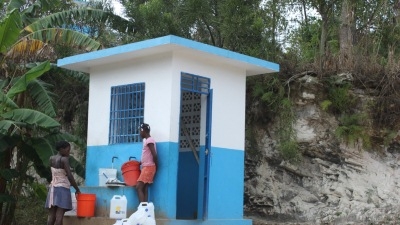Challenge
At the time the project was designed in 2006, limited resources (outside of the metropolitan area) for water supply in Haiti were mostly used for urban water supply in secondary towns. Due to lack of funds, the Ministry of Health’s rural water units were small and inactive. There was also no institutional home for sanitation. Without an institutional presence in rural areas and with little knowledge about levels of coverage and needs, it was thus difficult to prioritize investments, which were carried out in a piecemeal manner and did not necessarily reach the neediest citizens.
Local communities did not maintain infrastructure well and many rural water systems were managed by water committees often consisting of unpaid volunteers elected by the community. The performance of water committees varied widely, but most water committees seemed to not perform their functions adequately and collected insufficient funds for operation and routine maintenance.
Solution
The trust fund and the associated Bank grant were designed to address the challenges of bringing water supply to rural areas in a sustainable way and increase access to and use of water supply and sanitation services in participating rural communities. Communities were identified by evaluating their willingness to pay for water services (by the volume) and by using a participatory approach providing communities with a series of choices, including choice between different water service levels (house connection or water kiosk) and choice in the tariff structure and level (covering only operating costs and basic maintenance, or including a reserve for major maintenance). Project-financed activities targeted approximately 50,000 people, which represent 20 percent of the population of the participating communes.
This project’s key innovation is the introduction of a professional management model involving local water operators selected by the community to operate, maintain and manage the water supply systems based on a contract signed with the communities. Furthermore, the project promoted cost recovery, metering, and the use of water kiosks instead of standpipes, as well as gravity-fed piped systems to minimize potential technical issues. Where pumping was necessary and cost-effective, the project gave a strong preference to renewable energy, such as solar.
Results
The project focused on (i) increasing the sustained and effective use of safe drinking water in participating communities, (ii) improving use of sanitary and hygienic practices in participating communities, and, (iii) strengthening the capacity of the implementing agency, local water committees, and professional operators in cooperation with local Government. The program helped support improvements in several key outcomes:
- The construction of eight rural water supply piped systems in the Sud Department providing potable water to 33,700 people between 2009 and 2011. Works are still under progress with SPF grant funds and include:
- The construction of three water supply piped systems for an additional 10,500 beneficiaries; and
- The drilling of 14 boreholes to bring potable water to 6,500 people. It is estimated that these works in the Sud Department will be completed by July 2013.
- The construction of school latrines for 3,700 students and teachers and the promotion of sanitation and hygiene in six communities, covering approximately 30,000 people, in 2012.
- The introduction in 10 communities of a successful professional management model involving local water operators. These operators and community water committees were trained to operate, maintain and manage the water supply systems, as well as in basic financial management and community relations. This aspect of the project was initiated in 2009 and is still ongoing.
Bank Group Contribution
The US$5 million SPF Grant was awarded in November 2008 to complement the US$5 million Bank Grant signed on February 15, 2007 and closed on December 31, 2011. Both grants financed project activities through the National Directorate for Drinking Water Supply and Sanitation (DINEPA).

